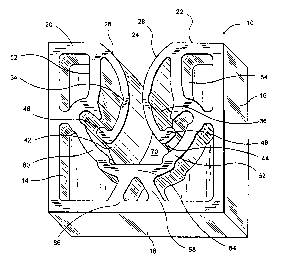Some of the information on this Web page has been provided by external sources. The Government of Canada is not responsible for the accuracy, reliability or currency of the information supplied by external sources. Users wishing to rely upon this information should consult directly with the source of the information. Content provided by external sources is not subject to official languages, privacy and accessibility requirements.
Any discrepancies in the text and image of the Claims and Abstract are due to differing posting times. Text of the Claims and Abstract are posted:
| (12) Patent: | (11) CA 2317192 |
|---|---|
| (54) English Title: | CLIP WITH FLEXIBLE LOCKING ARMS |
| (54) French Title: | CLIP AVEC BRAS DE VERROUILLAGE FLEXIBLES |
| Status: | Expired and beyond the Period of Reversal |
| (51) International Patent Classification (IPC): |
|
|---|---|
| (72) Inventors : |
|
| (73) Owners : |
|
| (71) Applicants : |
|
| (74) Agent: | FINLAYSON & SINGLEHURST |
| (74) Associate agent: | |
| (45) Issued: | 2003-11-25 |
| (22) Filed Date: | 2000-08-31 |
| (41) Open to Public Inspection: | 2001-04-18 |
| Examination requested: | 2000-08-31 |
| Availability of licence: | N/A |
| Dedicated to the Public: | N/A |
| (25) Language of filing: | English |
| Patent Cooperation Treaty (PCT): | No |
|---|
| (30) Application Priority Data: | ||||||
|---|---|---|---|---|---|---|
|
The clip includes two locking arms with proximal segments
joining the outer periphery, distal segments forming a tube pocket,
and hinge elements between the proximal segments and the distal
segments. The distal segments include outwardly turned locking
elements. An interior frame joined to said outer periphery
includes locking pockets complementary to the locking elements. A
tube pocket is formed between the distal segments of the locking
arms and a portion of the interior frame. As the distal segments
of the locking areas flex outwardly in response to the insertion of
a tubular element, the outwardly turned locking elements are urged
into the locking pockets.
Note: Claims are shown in the official language in which they were submitted.
Note: Descriptions are shown in the official language in which they were submitted.

2024-08-01:As part of the Next Generation Patents (NGP) transition, the Canadian Patents Database (CPD) now contains a more detailed Event History, which replicates the Event Log of our new back-office solution.
Please note that "Inactive:" events refers to events no longer in use in our new back-office solution.
For a clearer understanding of the status of the application/patent presented on this page, the site Disclaimer , as well as the definitions for Patent , Event History , Maintenance Fee and Payment History should be consulted.
| Description | Date |
|---|---|
| Time Limit for Reversal Expired | 2005-08-31 |
| Letter Sent | 2004-08-31 |
| Grant by Issuance | 2003-11-25 |
| Inactive: Cover page published | 2003-11-24 |
| Inactive: Final fee received | 2003-09-03 |
| Pre-grant | 2003-09-03 |
| Notice of Allowance is Issued | 2003-03-06 |
| Letter Sent | 2003-03-06 |
| Notice of Allowance is Issued | 2003-03-06 |
| Inactive: Approved for allowance (AFA) | 2003-02-25 |
| Application Published (Open to Public Inspection) | 2001-04-18 |
| Inactive: Cover page published | 2001-04-17 |
| Inactive: IPC assigned | 2000-10-11 |
| Inactive: First IPC assigned | 2000-10-11 |
| Inactive: Filing certificate - RFE (English) | 2000-09-21 |
| Letter Sent | 2000-09-21 |
| Application Received - Regular National | 2000-09-20 |
| Request for Examination Requirements Determined Compliant | 2000-08-31 |
| All Requirements for Examination Determined Compliant | 2000-08-31 |
There is no abandonment history.
The last payment was received on 2003-08-05
Note : If the full payment has not been received on or before the date indicated, a further fee may be required which may be one of the following
Patent fees are adjusted on the 1st of January every year. The amounts above are the current amounts if received by December 31 of the current year.
Please refer to the CIPO
Patent Fees
web page to see all current fee amounts.
| Fee Type | Anniversary Year | Due Date | Paid Date |
|---|---|---|---|
| Application fee - standard | 2000-08-31 | ||
| Registration of a document | 2000-08-31 | ||
| Request for examination - standard | 2000-08-31 | ||
| MF (application, 2nd anniv.) - standard | 02 | 2002-09-02 | 2002-08-13 |
| MF (application, 3rd anniv.) - standard | 03 | 2003-09-01 | 2003-08-05 |
| Final fee - standard | 2003-09-03 |
Note: Records showing the ownership history in alphabetical order.
| Current Owners on Record |
|---|
| ILLINOIS TOOL WORKS INC. |
| Past Owners on Record |
|---|
| MARK J. KWILOSZ |